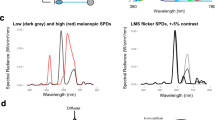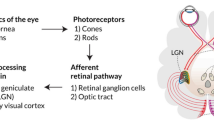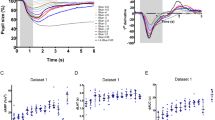Abstract
THE colour of a light is determined by such factors as its dominant wavelength, luminance, colorimetric purity, locus of retinal stimulation, surround chromaticity and preceding adapting field. Stiles and Crawford1 were first to note that the position at which a small pencil of light enters the pupil also affects the light's colour. In general, light that enters through the centre of the pupil is seen as brighter than the same light impinging on the same retinal area but passing through the periphery of the pupil. This is known as the Stiles–Crawford effect of the first kind (S–C I). It has been demonstrated that this effect is due to the directional sensitivity of the receptors2–4 and is much more pronounced in cones than in rods5–8. Stiles9 also showed that two monochromatic lights of the same wavelength, one passing through the centre of the pupil (on-axis), the other entering through the periphery (off-axis), will differ in hue even after they are equated for brightness. (There is also a small change in saturation that becomes almost negligible at the long-wavelength end of the spectrum.) This is known as the Stiles–Crawford effect of the second kind (S–C II). For example, to match in hue an on-axis light of 610 nm an observer might require an off-axis light of 605 nm. The direction and magnitude of this hue shift varies with the wavelength of the on-axis light (Fig. 1). We have measured S–C II in conditions of varying levels of bleached photopigment. An explanation of the effect based on the absorbance of the photopigment can account for much but not all of the data. For the long-wavelength end of the spectrum, when the photopigment is significantly depleted, some other factor must have a role in mediating this effect.
This is a preview of subscription content, access via your institution
Access options
Subscribe to this journal
Receive 51 print issues and online access
$199.00 per year
only $3.90 per issue
Buy this article
- Purchase on Springer Link
- Instant access to full article PDF
Prices may be subject to local taxes which are calculated during checkout
Similar content being viewed by others
References
Stiles, W. S. & Crawford, B. H. Proc. R. Soc. B112, 428–450 (1933).
Goldmann, H. Ophthalmologica 103, 225 (1942).
Fankhauser, F., Enoch, J. M. & Cibis, P. Am. J. Ophthal. 52, 767–783 (1961).
Ripps, H. & Weale, R. A. J. Physiol., Lond. 173, 57–64 (1964).
Crawford, B. H. Proc. R. Soc. B124, 81–96 (1937).
Stiles, W. S. Proc. R. Soc. B127, 64–105 (1939).
Flamant, F. & Stiles, W. S. J. Physiol., Lond. 107, 187–202 (1948).
Van Loo, J. & Enoch, J. M. Vision Res. 15, 1005–1009 (1975).
Stiles, W. S. Proc. R. Soc. B123, 90–118 (1937).
Brindley, G. S. J. Physiol., Lond. 122, 332–350 (1953).
Toraldo di Francia, G. J. opt. Soc. Am. 39, 324 (1949).
Enoch, J. M. J. opt. Soc. Am. 53, 71–85 (1963).
Snyder, A. W. & Pask, C. Vision Res. 13, 1115–1136 (1973).
Pask, C. & Snyder, A. W. in Photoreceptor Optics (eds Snyder, A. W. & Menzel, R.) 145–158 (Springer, Berlin, 1975).
Wijngaard, W. & van Kruysbergen, J. in Photoreceptor Optics (eds Snyder, A. W. & Menzel, R.) 175–183 (Springer, Berlin, 1975).
Enoch, J. M. & Stiles, W. S. Optica Acta 8, 329–358 (1961).
Miller, S. S. J. Physiol., Lond. 223, 89–107 (1972).
Walraven, P. L. & Bouman, M. A. J. opt. Soc. Am. 50, 780–784 (1960).
Dobelle, W. H., Marks, W. B. & MacNichol, E. F. Science 166, 1508–1510 (1969).
King-Smith, P. E. J. Physiol., Lond. 218, 101–102P (1971).
Rushton, W. A. H. & Henry, G. H. Vision Res. 8, 617–631 (1968).
Weale, R. A. Vision Res. 16, 1395–1399 (1976).
Wooten, B. R., Fuld, K., Moore, M. & Katz, L. in Visual Psychophysics and Physiology (eds Armington, J. C., Krasukopf, J. & Wooten, B. R.) 245–256 (Academic, New York, 1978).
Vos, J. J. & Walraven, P. L. Vision Res. 11, 799–818 (1971).
Author information
Authors and Affiliations
Rights and permissions
About this article
Cite this article
FULD, K., WOOTEN, B. & KATZ, L. The Stiles–Crawford hue shift following photopigment depletion. Nature 279, 152–154 (1979). https://doi.org/10.1038/279152a0
Received:
Accepted:
Published:
Issue Date:
DOI: https://doi.org/10.1038/279152a0
Comments
By submitting a comment you agree to abide by our Terms and Community Guidelines. If you find something abusive or that does not comply with our terms or guidelines please flag it as inappropriate.



